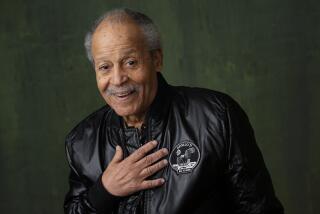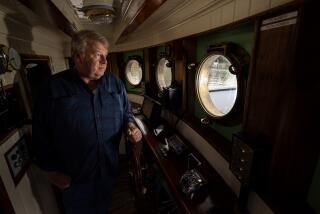Lifted on Wings of a Legend
- Share via
PITTSBURG, Texas — Every witness is long dead, even the boy who ran across the prairie that morning to tell his parents that he had just seen a machine fly. Within days, the airship would be gone, destroyed by a storm so fierce they say it broke eggs in chicken coops and ripped bark off cedar trees.
From its opening chapter -- the blustery morning when an 850-pound contraption flew for a few precious seconds over a Texas pasture -- the story has been problematic. There are no patent records, no surviving blueprints, no photographs proving that Pittsburg’s adopted son, not the Wright brothers, was responsible for the first powered flight.
Maybe the tale of this old railroad town, though, isn’t so much about how legends are born, but how they stay alive. East Texas is a place where little towns like this can shrivel up and blow away, where Main Streets get boarded up, old people wait to die and the young can’t wait to leave. Pittsburg is making do, partly because it has a good story to tell.
One hundred years ago today, the Wright brothers flew over the dunes of Kill Devil Hills, N.C. History books say those flights -- which were photographed and meticulously documented for a world that had become intrigued with flying -- paved the way for the modern airplane and changed the pace of life, from recreation to commerce.
That’s not quite the way they tell it in Pittsburg, a town of about three square miles and 4,300 people. Here, they believe the Rev. Burrell Cannon, an itinerant Baptist minister and sawmill operator, sent a machine he called the Ezekiel Airship into the air, a year before the Wright brothers’ flights.
Today, a gaggle of aging men have dedicated their golden years to keeping Cannon’s legend alive.
The friends and amateur historians -- including Mayor D.H. Abernathy, 91, who has been in office for 50 years -- are a cantankerous bunch who drive pickups and call homeless people hobos. When they wear ties, which isn’t often, the skinny end pokes out below the fat end. Their conversations are often tinged with the incessant whistle of hearing aids. They are, to a man, hell-bent on correcting the record.
“After all,” said Abernathy, “it was a full year before the Wright brothers. That is a fact. Well, close enough.”
Drawn to Texas
Cannon was born in April 1848, in Coffeeville, Miss., but was soon drawn to the frontier of East Texas -- namely, to its untapped hardwood forests.
“He was in the sawmilling business,” said Glenn Gordon, 72, a retired chemical plant operator and one of Cannon’s three surviving grandchildren. Gordon, Abernathy and a handful of others met on a recent morning at the Northeast Texas Rural Heritage Museum in Pittsburg, much of which is devoted to the Ezekiel Airship.
“They had hauled off most of the timber out of Mississippi,” Gordon said. “And this was virgin territory. So he came here.”
A handsome, square-jawed man who stood 6-foot-4, Cannon was a Renaissance man in an industrial age.
Armed with a keen understanding of engineering, much of it passed down from his father and a blacksmith he worked for as a young man, he patented a half dozen inventions. They included a marine propeller, a type of windmill and a camera designed to photograph people as they stepped onto trains.
Carrying a tattered Bible, he preached on the side, mostly in one-room schoolhouses in East Texas towns that didn’t yet have a church. Some say he spoke eight languages and spent time in the Foreign Service before the Civil War. He once told a friend that he was rich twice, poor twice, and married four times.
In the late 1890s, he decided he wanted to fly.
He persuaded a local businessman named P.W. Thorsell to let him build his ship in the top floor of a foundry Thorsell owned. Cannon incorporated the Ezekiel Airship Manufacturing Co. in 1901 and sold $20,000 worth of $25 stock certificates to raise money. With three full-time employees, his airship came together quickly.
He named his 26-foot-wide machine, which looked like a box kite, after the biblical account of the prophet Ezekiel, which speaks of “living creatures” that were “lifted from Earth.”
Covered in sailcloth, it was also designed largely through biblical inspiration, right down to an apparatus Ezekiel described in the Bible as a “wheel within a wheel.” Cannon, convinced the passage was effectively an instruction manual for ascending toward God, used those words to piece together the key components of the ship: four giant, interlocking wheels that turned a series of wooden, hinged paddles.
The airship could carry a single pilot, who would sit upright and control it by maneuvering a series of levers, said Bob Turner, 81, another member of the group and a retired aerospace engineer. The ship, powered by a four-cylinder gasoline engine built by Cannon, was designed to take off like a plane but land vertically, like a helicopter.
By 1902, it was ready to go. It is here, though, that a proud legend becomes a bit porous: No one’s sure how he got the airship out of the building.
“They had to tear out the wall to get it out!” Abernathy said.
“Abernathy, come on,” Turner said. “I don’t believe that.”
“I’ve seen the bricks that were torn out and had to be put back!” the mayor replied.
In any case, on a Sunday morning in 1902, the ship somehow emerged onto a pasture near the foundry, which is now a butane distribution yard.
Cannon decided he was too heavy to fly, so a skinny foundry worker named Gus Stamps took the helm.
The engine roared to life, the paddles spun, lifting the airship at least 10 feet. For a few seconds, according to eyewitness accounts that have been passed down through generations and recorded by the museum, the ship remained aloft before lurching toward a wooden fence, scattering a group of children who had straddled it to watch. Terrified of the violent vibrations coming from the engine, Stamps shut it off and set it down. But Cannon’s machine had flown.
Within days, he loaded it onto a railroad flat car and headed east for Texarkana, Texas, where he was scheduled to give a lecture and show off the ship. From there, it is believed he was headed to St. Louis, where, at the 1903 World’s Fair, a reward of $100,000 was being offered for anyone who could make a “sustained, controlled flight.”
Cannon didn’t make it.
A storm blew in, derailed the rail car and destroyed the ship east of Pittsburg. No one is sure why the pieces weren’t preserved. There are no photographs of the flight, just a single, faded photo of the airship believed to have been taken inside the foundry.
Although there were several newspaper accounts of the airship while it was being assembled, there was none of the flight itself. Some say Cannon was sure there were spies in town, maybe from foreign countries, and shunned publicity as a result.
Cannon built a second ship 10 years later. That one hit a utility pole and broke apart. The reverend, telling acquaintances that “God never willed that this airship should fly,” was done with the airplane business.
Cannon died in 1922. There was no obituary, and his gravestone makes no reference to his flight.
Historians, for the most part, do not doubt that Cannon built a machine that lifted into the air. However, they point out that there were several distinctions between his flight and the Wright brothers’ -- primarily that the Wright brothers could steer.
“You have to look at the definition of flight,” said Jim Cross, a park ranger at the Wright brothers National Memorial in Kill Devil Hills, N.C.
“If you go up in a balloon or jump off a hill in a glider, you’re up in the air, sustained by a craft, but is that flying? What the Wright brothers did is they had the first controlled, powered flight. They had control over all three facets of flight: pitch, roll and yaw.”
Lacks Written Record
There just isn’t enough documentation to verify the Pittsburg flight, said Tom Crouch, senior curator of aeronautics at the Smithsonian’s National Air and Space Museum.
“For my money, the Wright brothers were the first,” he said. “They have the evidence in diaries, letters, pictures, other people’s accounts, you name it. “
Cannon’s devotees make it clear that they do not want the Wright brothers removed from history books. They want Cannon and his airship mentioned with the other pioneers who had attempted powered flight before the Wright brothers, including several who claimed to have been the first to succeed.
“The Wright brothers deserve everything they got. We just want to put it into context,” said John Holman, 81, a retired furniture merchant and another of the amateur historians working to keep Cannon’s tale alive. Holman recently self-published “On the Wings of Ezekiel,” an exhaustive, hardback account of Cannon and his achievements that’s sold at the museum.
“Cannon was serious, he was smart and he was capable,” Holman said. “This is very real. It happened. Think about it: Nobody knew what an airplane was supposed to look like yet. At least he had God designing his.”
The friends and historians are as protective of Pittsburg itself as they are of Cannon’s place in history.
Indeed, some believe those two things -- the town and the legend -- have only survived because of each other. There can be a fine line between historic and run-down. Pittsburg remains in the former category, largely because of the Ezekiel Airship.
Founded in 1855 by Major William H. Pitts, Mayor Abernathy’s great-great-great uncle, Pittsburg’s primary industry is poultry. It is the corporate home of Pilgrim’s Pride Corp., one of the nation’s largest chicken processing companies.
While Pilgrim’s Pride provides jobs, it is the airship that rests at the heart of the town’s image and character.
The ship, for instance, is on the city logo. The museum remains the biggest draw in town. Its exhibits include a replica of the airship hanging from the ceiling and Cannon’s Bible encased in glass, open to the book of Ezekiel. And for three years running, mostly because of its historic character -- which is based largely on the airship -- state and national cultural commissions have named Pittsburg a “Main Street” town.
That declaration, though largely symbolic, has attracted programs for preservation and economic development in the town’s historic areas. Investment in downtown -- a combination of grants, government projects and private money -- has totaled $6.5 million in recent years, no small amount when one considers that Pittsburg’s annual budget is less than $4 million.
Pittsburg’s downtown is thriving with craft shops, cafes and restaurants. Several bed-and-breakfasts have opened in stately homes that might have been otherwise lost to neglect. Pittsburg has enjoyed beautification projects, from the addition of spotlights in front of historic estates to the burying of utility lines.
“This has all been done,” Abernathy said, “to make this a better place to live.”
But some fear there is trouble on the horizon.
“The truth is,” Turner said, “it’s all held together by a bunch of old people.”
Turner and the rest of the group have tried hard in recent years to get young people interested in the Cannon legacy, but they haven’t had much luck. Some of them worry that the story will start to fade, and then, someday, vanish for good.
“My children don’t think too much about it. And I don’t know who else of that generation does,” Gordon said. “We just want Rev. Cannon to get his due. But at some point, there might not be anybody left to tell his story.”
*
Staff researcher Lianne Hart contributed to this report.
More to Read
Sign up for Essential California
The most important California stories and recommendations in your inbox every morning.
You may occasionally receive promotional content from the Los Angeles Times.











